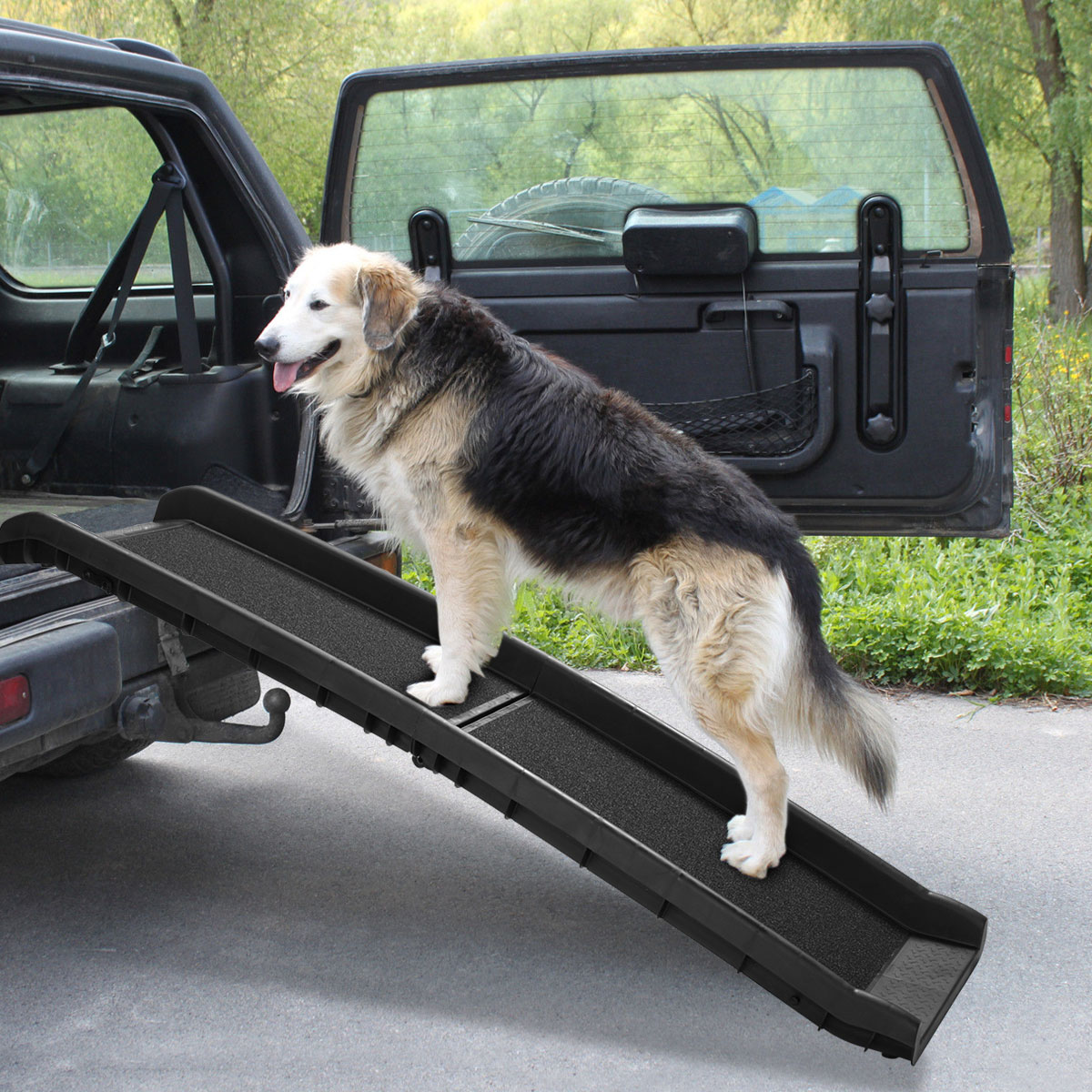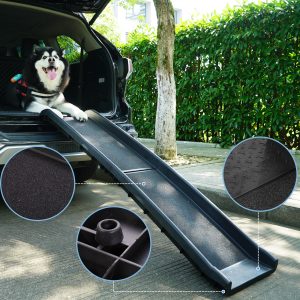Dogs have no qualms about leaping onto the bed, sofa, or into the car to be close to their favorite people. However, if your dog appears to require a lot more coaxing to join you, it’s a sign that the transition will be difficult for your best friend. If your dog’s short legs and small stature necessitate Superman-like leaps, they may injure a knee or paw, especially if they land on a hard surface, such as cement. In short, jumping on and off a higher perch is a high-load activity that can be taxing on your dog’s joints, causing inflammation or even injury. That’s where a ramp or a set of pet stairs can come in handy, allowing your pet to move around safely and comfortably.
Does your dog need stairs or a ramp?
Some dogs’ legs appear to have springs. But if any of these describe your dog, he or she is probably a good candidate for a ramp or a set of pet stairs.
- Arthritis can develop in senior dogs, even if they haven’t slowed down yet.
- Dogs displaying signs of hip or joint problems. When they run and play, do they limp or tuck a leg? If you’ve noticed that they require more coaxing than usual, it’s time to have them checked out.
- Smaller dogs, particularly those who are constantly leaping to or from great heights.
- Back injuries are common in dogs with long spines, such as dachshunds and corgis. Jumping can aggravate these issues.
- Overweight canines. The act of launching and landing can put extra strain on a dog’s joints; add a few pounds, and they’re at risk of injury.
- Dogs who are recovering from a paw, leg, or hip injury.
Should dogs be allowed to jump?
Jumping in isn’t necessarily a bad thing. After all, it can be great exercise when done safely, and it’s an event you’ll find on any dog agility course. There are two keys to safe jumping for healthy dogs: the height should be appropriate for your dog’s size, and the surface should be safe, skid-free, and not provide a hard landing. Otherwise, jumping can cause injury and joint problems.
Arthritis occurs when the cartilage layer between two bones in a joint is damaged or worn away. According to the Arthritis Support Network, one in every five dogs will develop arthritis during their lifetime. Jumping and landing on a too-high surface repeatedly can definitely cause the type of orthopedic trauma that leads to the early onset of arthritis.
Jumping can also result in sprained ankles, broken toes, strains, sprains, and inflammation.
If jumping is painful for your dog, is it OK to lift them?
If your dog is in too much pain to jump onto the couch or into the car, make sure you’re lifting them without aggravating the situation. Don’t grab them under the armpits like a small child, as this can be painful. Lifting a dog is easiest when one arm is placed under the chest and the other under the rump. If your dog reacts by flinching or growling, he is in pain and you should stop. (Your dog’s veterinarian or health care provider may have additional recommendations for safe lifting.)
A lift harness, which distributes pressure throughout the chest and abdomen area, can be used to safely assist a larger dog (while keeping pressure off the neck). Check out your neighborhood pet store for some great options.
How high is too high?
Is your small dog worried that the couch is too high for him? Maximum jump heights for dog agility courses can provide some guidance. They consider the dog’s size to reduce the risk of injury during training and competition.
First, determine the withers height by measuring the distance between the top of the dog’s shoulder blades and the ground. Then, look up the corresponding maximum height for jumping obstacles.
According to the North American Dog Agility Council‘s guidelines, a small dog with a withers height of 11 inches would jump over a hurdle that was no more than 4 inches off the ground. A tall dog of 18 inches or more would jump no higher than 16 inches.
To be sure, jumping over an obstacle is not the same as jumping up onto a bed, couch, or truck. But, if falling from a certain height is deemed dangerous on the agility course, why would it be safer on the living room floor or driveway?
Stairs vs Ramp: Which is best for my dog?
Steps have the advantage of being smaller in size than ramps and thus taking up less space. They won’t stick out nearly as much if they’re parked on one end of the couch or bed, posing a tripping hazard to the humans in the house. When not in use, this also makes a stair set easier to transport and store. This can be a great option if your dog is healthy and using the stairs isn’t painful.
Ramps are ideal for dogs suffering from joint or hip pain, as well as arthritis, because they allow them to step rather than lift their knees, hips, and shoulders as they would for a stair tread. They’re also ideal for short-legged dogs. The important thing is to ensure that the ramp’s angle is low enough for your dog to walk around painlessly. (An overly steep incline won’t help.)
Whatever option is best for your dog, be sure to visit your locally owned pet supply store to find out what works best for your pet. Here are a few things to think about while shopping.
- Look for an anti-skid surface to prevent your dog from sliding or skidding.
- Proper width is essential for safe stepping, so make sure it’s big enough for your biggest dog.
- A bottom grip for the ramp or stairs will keep the structure from sliding while in use.
- Select the appropriate slope for your pet. If your dog has to work hard to get up, a lower angle is a better, less painful option.
As your dog ages, choosing the right diet can help your best friend look and feel their best. Coziwow comes in kinds of pet ramps. For a long and healthy life, find pet supplies at your local, independent pet retailer.

